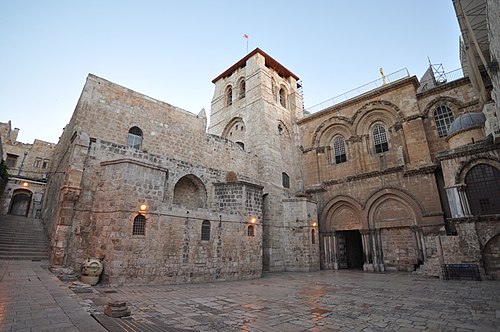Top Qs
Timeline
Chat
Perspective
September 13 (Eastern Orthodox liturgics)
From Wikipedia, the free encyclopedia
Remove ads
Sep. 12 - Eastern Orthodox liturgical calendar - Sep. 14

All fixed commemorations below celebrated on September 26 by Orthodox Churches on the Old Calendar.[note 1]
For September 13th, Orthodox Churches on the Old Calendar commemorate the Saints listed on August 31.
Feasts
- Forefeast of the Exaltation of the Cross.[1][2][3]
Saints
- Hieromartyr Cornelius the Centurion (1st century)[1][3][4][5][note 2]
- Saint Aristides the Athenian, martyr (120)[3][6][note 3]
- Martyrs Serapion, Cronides, and Leontius, of Alexandria (c. 237)[1][3][7][8] (see also: September 11)
- Martyr Straton of Nicomedia (3rd century)[1][3][9][10][note 4]
- Martyr Seleucus of Galatia (320)[1][3][9]
- Martyrs Elias, Zoticus, Lucian, Valerian, Macrobius, and Gordian at Tomis in Moesia (320)[1][3][9][11]
- Saint Eulogius I, Patriarch of Alexandria (608)[1][note 5]
- Venerable Peter of Atroa, in Bithynia (or of Agrea) (early 9th century)[3][13][14] (see also: January 3)
Remove ads
Pre-Schism Western saints
- Saint Philip, the father of St Eugenia of Rome, in whose home Sts Protus and Hyacinth were employed (3rd century)[15][note 6]
- Saint Litorius, Bishop of Tours (370)[1][16]
- Saint Maurilius of Angers, Bishop of Angers (c. 430)[15][note 7][note 8]
- Saint Nectarius, Bishop of Autun in France, and a friend of St Germanus of Paris (c. 550)[15][note 9]
- Saint Amatus (Amat, Amé, Aimé, Amado), first abbot of Remiremont Abbey (627)[15][note 10][note 11]
- Saint Venerius the Hermit, a hermit, then abbot on the Island of Tino in the Gulf of Genoa in Italy (c. 630)[15][note 12]
- Saint Columbinus, successor of St Deicola as Abbot of Lure in France (c. 680)[15]
- Saint Amatus (Aimé), Abbot of Agaunum, who became the tenth Bishop of Sion in Valais in Switzerland (690)[15][note 13][note 14]
- Saint Barsenorius, Abbot of La-Croix-Saint-Leuffroi in France (7th century)[15][note 15]
- Saint Hedwig (Haduwy), Abbess of Herford Abbey in Westphalia in Germany (c. 887)[15]
- Saint Wilfrida of Wilton (Wulfthryth), Abbess of Wilton Abbey (c. 988)[15][note 16]
Post-Schism Orthodox saints
- Saint John of Prislop, Romania (15th-16th centuries)[1][17]
- Saint Cornelius of Padan-Olonets, disciple of St. Alexander of Svir, and with him Sts. Dionysius and Misael (16th century)[1][16]
- Saint Meletius I Pegas, Patriarch of Alexandria (1601)[18][19]
- Great-martyr Ketevan, Queen of Kakheti, Georgia (1624)[1][16][20][21][22]
- Venerable Hierotheus of Kalamata (Hierotheos the New), monk of Iveron Monastery, Mt. Athos (1745)[1][3][16][23][24]
New martyrs and confessors
Remove ads
Other commemorations
Icon gallery
- Cornelius the Centurion and destruction of the pagan temple at Skepsis.
- St. Eulogius I, Patriarch of Alexandria.
- Church of the Resurrection (the Holy Sepulchre) at Jerusalem.
Notes
- The notation Old Style or (OS) is sometimes used to indicate a date in the Julian Calendar (which is used by churches on the "Old Calendar").
The notation New Style or (NS), indicates a date in the Revised Julian calendar (which is used by churches on the "New Calendar"). - Certain Synaxaria show his feast day on September 9 as well.
- Born in Milan in Italy, he moved to France where he became a disciple of St Martin of Tours. About the year 407 he was consecrated Bishop of Angers.
- See: (in French) Nectaire d'Autun. Wikipédia. (French Wikipedia).
- Born in Grenoble in France, he became a monk at the monastery of St Maurice of Agaunum in Switzerland, where he lived as a hermit for over thirty years. St Eustace encouraged him to move to Luxeuil and here he converted St Romaricus. When this noble founded the monastery of Remiremont in 620, Amatus became the first abbot.
- As a result of a false accusation, he was exiled to the monastery of Péronne and then to Breuil near Arras in the north of France, where he lived as one of the monks.
- His relics are in Fécamp.
- Mother of St Edith of Wilton in England. After Edith's birth, Wilfrida went to Wilton where she became a nun. As a nun, and later as abbess, she led a repentant and edifying life.
Remove ads
References
Sources
Wikiwand - on
Seamless Wikipedia browsing. On steroids.
Remove ads






